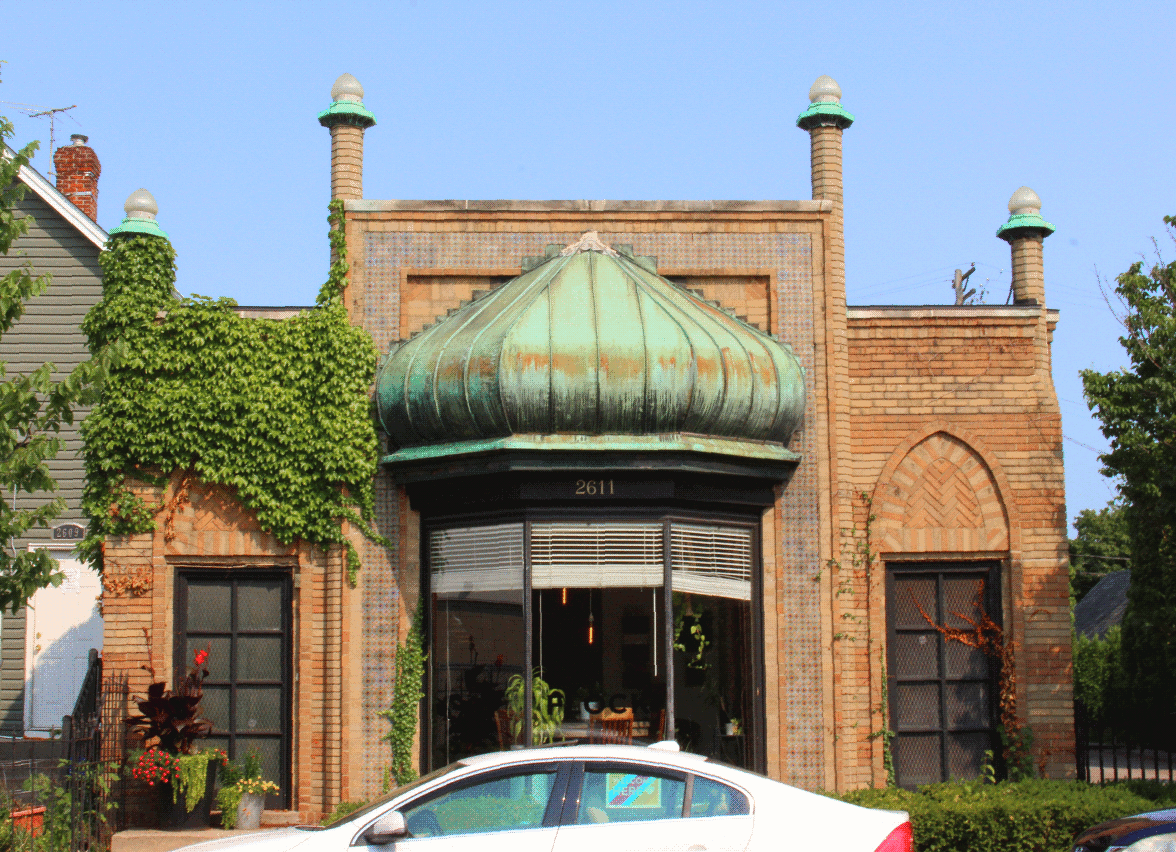
Address: 2611 Stevens Ave
Built: 1929
Description: A one-story brick building with a deep, narrow footprint. The facade is symmetrically divided into three rectangular sections whose upper corners are marked by four narrow, octagonal brick towers terminating in pointed dome-shaped lamps. The center and largest section of the facade extends above the roofline to frame a prominent bay window topped by a distinctive half-onion-dome-shaped copper form. Bands of multicolored brick and tile reinforce the horizontal and vertical lines of the facade, setting off the curved forms of the central dome and bricked-in arches above the side windows.
I happened upon this building in my neighborhood a few years back, and I have always been charmed by its modest scale, balanced proportions, fanciful geometry, and lively brickwork. Of course the octagonal lamp towers and central half-dome are what (literally) stand out at first glance, but take another moment to check out all the other little details that frame and support those showy projections. I'm talking about the wide rectangular band of geometric tile that serves as a backdrop to the central window and dome, the multiple textures of bricklaying that embellish the narrow side windows, the way the outer towers gracefully intersect into the corners of the building rather than just sticking out of the roof. Also, check out that sedan parked in front for scale. This building is smol. It is cute.
The sides and back have less going on, although one fun detail is a pair of V-shaped indents about halfway back on either side, dividing the long, narrow floorplan into two segments as though it's wearing a belt. I imagine these angled walls and windows might provide a touch of geometric interest to the otherwise rectangular interior spaces.
Ok that's enough appreciation, let's talk about the elephant in the rectangular interior space. This building's distinctive features are specifically evocative of Islamic architecture, right? Onion domes, though not exclusive to Islam, are not exactly common here in the upper Midwest, and what I've been calling "lamp towers" are probably more aptly described as pseudo minarets. (Minarets being structures that are exclusive to Islamic architecture, and "pseudo" being a word that means "fake.") So what's going on? Why these decorative features, which are so unusual for this region?
Disappointingly if unsurprisingly, the answer is basically "Orientalism." 2611 Stevens Avenue was constructed to house a new rug cleaning department for Despatch Laundry, a thriving business that had been established in Whittier since the 1890s and already occupied multiple buildings on the block by 1929. And what does this have to do with the ? Well, "Oriental" rugs in particular, which were apparently enjoying a peak of U.S. popularity at the time. (A newspaper ad announced "A New Building Devoted to Rug Cleaning With Special Provision for the Scientific Care of Orientals," and assured readers that "This new department is under the management of Mr. Paul A. Keljik, formerly manager of one of Minneapolis' largest Rug cleaning departments." Incidentally, Keljik and his relatives appear to have been some of the earliest Armenian immigrants to reside in Minnesota, and ) Anytime an act of aesthetic mimicry is specific enough to evoke a certain region, culture, or tradition, we have a responsibility to ask "why," and